
Angelina Konovitz-Davern and Jennifer Cook, August 24, 2017; digital photograph
Angelina Konovitz-Davern's summer intern experience at the Burchfield Penney Art Center
Monday, Aug 28, 2017
In order to fulfill my internship requirement for my school’s undergraduate Museum Studies program, I spent the summer interning at the archives of the Burchfield Penney Art Center. My choice was influenced by not only the museum’s proximity to home but also by my fond memories of visiting the Burchfield during my adolescence. Although I didn’t fully realize I wanted to work in museums until my second year of college, I’d like to believe the Burchfield unconsciously steered me onto my current career path.
Thankfully, barriers to interning at the Burchfield were almost nonexistent. I was interviewed by archivist Heather Gring, but it felt more like a comfortable conversation than an interview. We discussed my school experiences, the Burchfield itself and the types of projects I would be interested in working on. I knew this was definitely an opportunity not to be missed.
Overall, I’m very glad my first experience interning at a museum was at the Burchfield. I had previously volunteered at the Buffalo Science Museum during high school, but the experience lacked meaningful museum work because I was young and had yet to understand the kind of work I’d like to do. This experience, however, was quite the opposite. My supervisor, Heather, was excellent. She did not hesitate to involve her interns with major projects and always made sure we were invested in what we were working on. Heather provided effective guidance yet allowed me to maintain a sense of independence. I enjoyed interacting with other staff as well, including other interns and Jennifer Cook, who is currently researching the Artpark archives.
My most major project I completed while interning at the Burchfield was processing the Sharon Mendola Archival Collection. This archival collection, donated to the Burchfield in 2016, contains documents and personal papers for understanding the life and career of Western New York artist and Buffalo State professor Sharon Mendola. I had previously processed archives as part of a college course, but this project was on a much greater scale. Collaborating with two other interns, I went through Mendola’s papers, artwork, and photographic material and rehoused them into acid-free folders. These folders were labeled and categorized into archival series, which are groups of similar records that are created due to said records serving a certain function or relating to a particular subject or activity. Since Mendola had a career in both art and teaching, for example, it was necessary to create separate series for her artistic career and for her tenure at Buffalo State. It was an excellent decision on Heather’s part to have us interns collaborate on this project. Working together enabled us to communicate and talk through any difficulties while learning from each other. Investigating the documents was a fascinating experience as well. Although it could not be helped, sometimes I felt a little intrusive looking through this material window into Mendola’s life. I especially liked seeing her artwork evolve over the years, either from her sketchbooks or from her transition to computer art during the 1990’s.
After completing our inventory of the Sharon Mendola Archival Collection, we compiled a finding aid, which is a document that provides information about a collection within the archives. Compiling this extensive document and putting our names on it left me with a sense of accomplishment. I hope this finding aid will effectively help facilitate research into this collection in the future.
One of my tasks I completed while developing the finding aid was writing a biography for Sharon Mendola. It was then decided that I should use my writing skills to continue writing biographies for the Burchfield. Therefore, I began writing biographies for all of the artists that completed an artist-in-residency at Artpark in Lewiston, New York. This project has not only helped me learn more about local history but also about art and its movements during the last century. It has been interesting to see how different artists have connected and how their careers have evolved since Artpark. My regret is not being able to get through many years of biographies. However, Artpark hosted over 100 artists during its first four years. The amount that completed a residency from 1974 to 1991 must be at least twice that amount.
Although I mainly worked in the archives or the collections study center, I still had the opportunity to work in the gallery. One of my most memorable experiences during my internship was installing artwork to be auctioned off at a gala in June 2017. Having never hung artwork before, I was a little nervous I would mess up and throw off the upcoming auction. However, it went well and was a valuable learning experience. I learned the precise measurements that went into putting artwork on the wall and how important proper
I’d consider my summer in the archives a summer well spent. My work felt meaningful and I learned several valuable skills I’ll use in the future. This internship also made me consider a career in art museums, a path I was previously unfamiliar with. I would like to thank Heather and the rest of the Burchfield staff for helping me make the most of my experience. Given the opportunity, I would definitely work at the Burchfield again.
Angelina Konovitz-Davern, August, 2017